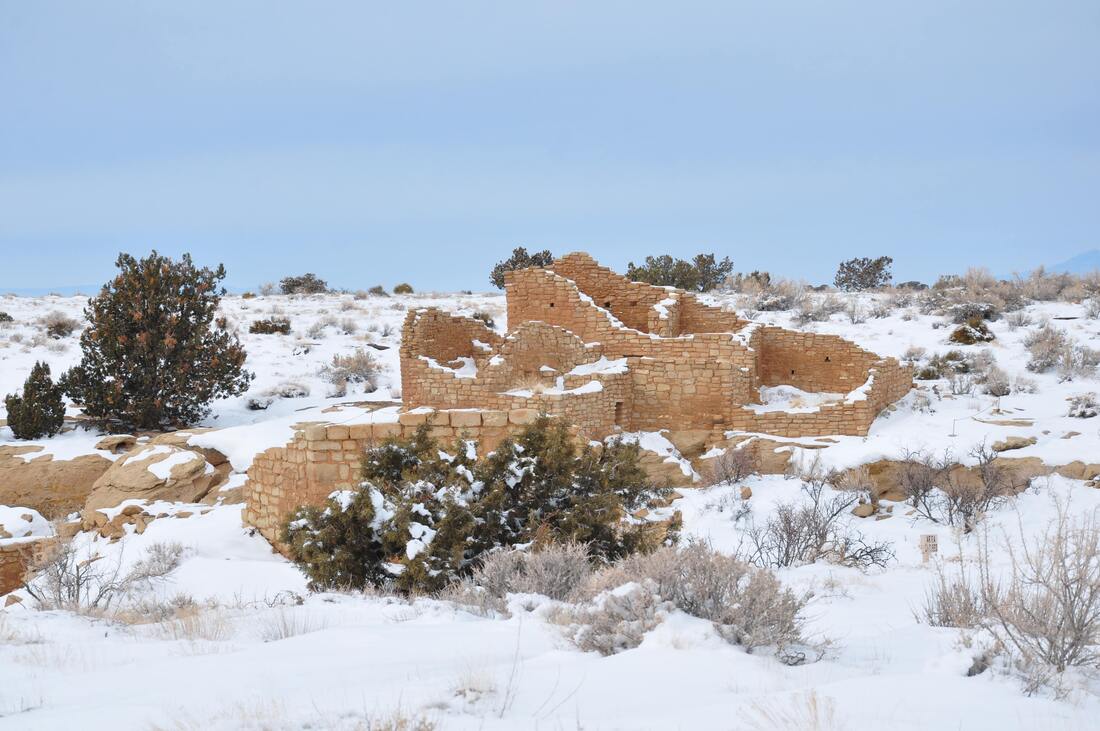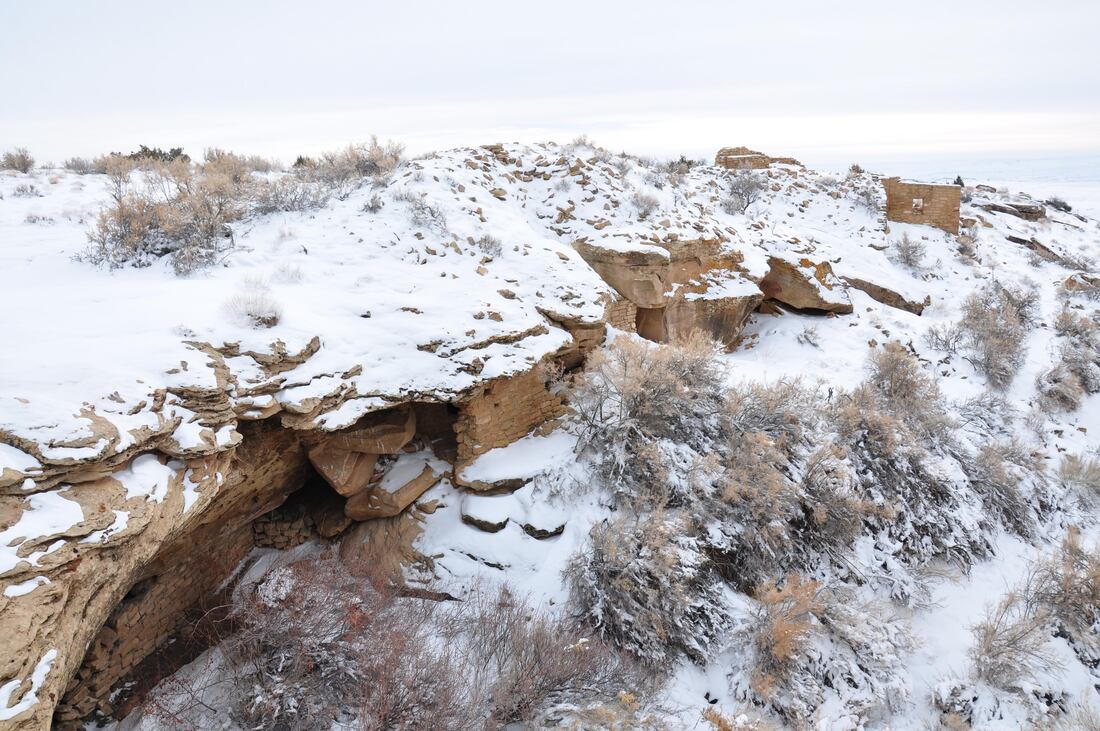|
00:00 Title
00:18 Cajon Pueblo Group & Wild Horses 08:32 Square Tower Trail 20:46 Fin Doing a winter season hike does not always require wearing snowshoes. Snowshoes are practically useless in the light flour snow that is found in some of the high elevation desert regions when the temperatures are below freezing. This kind of dry flour snow can get deep, but when tread upon it easily compacts to a thin layer of firm dense snow. Boots and waterproof leggings are all that is needed for blazing a trail through this kind of fluffy snow without getting wet. After a trail is blazed, anybody that follows will have an easy time getting through. Driving a vehicle to a remote winter season destination does require preparing for snow covered road conditions. The busy county and BLM dirt roads way out in the country are usually maintained when snow falls, but on the other hand, the seldom used dirt roads out in the middle of nowhere may not see much of any snow removal maintenance at all. This is especially true for federal property access roads during events like a government shutdown. A foot or two of loose fluffy snow on a remote high desert dirt road can be conquerable if you drive a capable vehicle! The same conditions that hikers face in loose fluffy snow also apply to 4×4 pickups, ATVs and Jeeps. As long as a driver knows where the dirt road goes and what hazards may be found, driving when the dirt road is covered with more than a foot of loose fluffy snow should not be a problem. In fact, driving over fluffy flour snow will pack it down like hard pavement, so the trip back out will be even easier. Knowing when the conditions are too risky for getting stuck is the primary safety factor when driving a 4×4 on a snow covered dirt road. If the ground is frozen, the trip should be a breeze. If the underlying ground is muddy, then it might be best to call the trip off, because the high desert silt mud can be deep. Knowing when snow chains will be needed is a plus too. Getting stuck in a remote desert region with little hope for rescue can present a survival situation, so it is best to reduce risks. For this reason it is best to prepare for the worst and pack some winter camping gear for the trip, even if only a daytime venture is planned. The reason why the snow covered desert dirt road driving information was mentioned is because a visitor will have to travel on ice and snow covered county roads just to get close to the Cajon Pueblo Group during a winter visit. Decisions will have to be made as to whether blazing the fluffy snow covered dirt access road with a 4×4 is worth the risk or whether it is better to double the length of the hike after parking the vehicle by the maintained county dirt road. Either way, there will be a little bit of snow hiking involved, because the access road ends at a parking area a few hundred yards away from Cajon Pueblo Trailhead entrance gate. The Cajon Pueblo Group location is not the easiest place to find on a map and the roads in this region change names as they cross the boundaries of Utah, Colorado and the Navajo Nation. These remote county roads are pictured in most GPS systems, but what these roads are named can vary from one mapping system to the next. Paper maps that clearly show how to get to the Cajon Pueblo Group can be obtained at the nearby Hovenweep National Monument Visitors Center. Why bother to visit an ancient native pueblo way out in the middle of nowhere when the ground is covered with snow? ... The answer lies in the eyes of the beholder or to be more specific, the eyes of whoever is holding the camera! Snow covered ancient pueblo ruins are good topic material for dramatic looking photos, especially when an artistic touch is applied behind the lens. As an added bonus, wild horses frequent the Four Corners region, especially near Hovenweep, so there may be good opportunities to photograph wild horses in the snow as well! To make a long story short, all of the pieces of the puzzle fell in the right places during my winter season visit to the Hovenweep National Monument-Cajon Pueblo Group. I was driving a 4×4 Jeep, so I had it made in the shade, as far as traversing snow and ice covered roads were concerned. Driving under the speed limit while locked in four wheel drive mode ensured a safe trip there and back. Even when blazing through the deep fluffy snow covered National Park Service dirt road, there were no problems. After arriving at the parking area, navigating the hiking path to the ancient pueblo was easy when stomping through the light fluffy snow covered ground. Just like usual at Hovenweep, there were plenty of wild horses hanging around, so I took my time when doing the short hike. This entire region is free range ranching territory, so it can be difficult to tell which are the farm horses and which are the wild ones. Sometimes the local domesticated horses roam with the wild horses, but they usually head back home after remembering where their food and water comes from. One of the easiest ways to recognize the wild horses in this region is to look at their mouth. If the horse’s mouth and lips look swollen, then the chances are that the horse is a wild one that has been eating cactus when no other food can be found. Shaggy manes, untrimmed tails, matted hair and the lack of brands on the hide are also signs that a horse is on the wild side. After taking a few pictures of the wild horses in the winter snow, the rest of the hike to the Cajon Pueblo Group went fairly easy. The Cajon Pueblo Group is related to the other nearby ancient pueblo complexes in this maze of high mesa canyons. For those who have seen the Horseshoe, Hackberry and Holly Pueblo Groups in Hovenweep National Monument, it will be evident that the Cajon Pueblo was built by the same culture. There are hundreds of archeological sites in this region and a complex communication system helped to protect the pueblos that were hidden in the canyons. Most of the unrestored buildings on the high ground were actually lookout posts, that guarded the hidden food storage silos, cisterns, agricultural areas and pueblos near the canyon rims. For a visitor, the Cajon Pueblo Group is another piece of the puzzle that will surely provide more insight into the native cultures that have called the Four Corners region their home since ancient times. Visiting an ancient sacred place like the Cajon Pueblo Group at Hovenweep National Monument when the ground is covered with winter snow is a rewarding experience! For those who only have given thought to visiting desert destinations during the heat of summer, a refreshing hike through the snow in the dead silence of a remote wilderness is an experience that will awaken the soul. This is especially true when the picture perfect conditions include views of wild horses and snow draped ancient pueblo walls. No matter whether it is summer or the dead of winter, the trek to see the Cajon Pueblo Group at Hovenweep is well worth the effort!
1 Comment
Your comment will be posted after it is approved.
Leave a Reply. |
Leave no trace!
New!
Destination West YouTube channel! https://www.youtube.com/@DestinationWestOrg *The Destination West website upgrading project is well underway. Unique YouTube slideshows are replacing the outdated Flickr photo galleries. The new videos feature modern graphics and alternative music instrumentals that enhance the viewing experience. Some articles are being condensed, while others are getting much needed edits. As everybody knows, the bulk of the original articles and photos were published on the fly during the Covid camping venture and there were limitations. Upgrading is the way to go and more articles will receive a makeover each week until this project is completed. After that, I will be able to gather new material. There is light at the end of the tunnel!
JD Lane Archives
July 2024
Donations help the Destinaton West project continue into the future!
Go Fund Me! This website uses marketing and tracking technologies. Opting out of this will opt you out of all cookies, except for those needed to run the website. Note that some products may not work as well without tracking cookies. Opt Out of Cookies |












